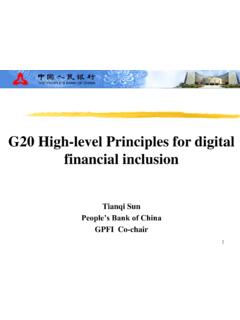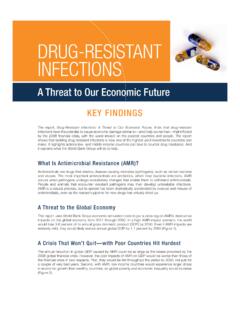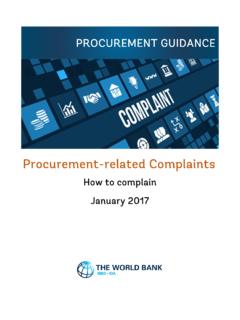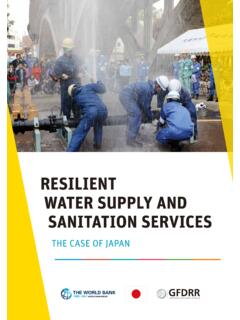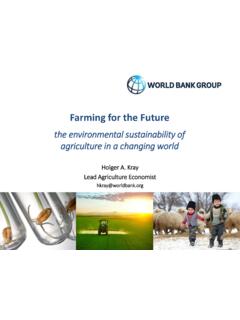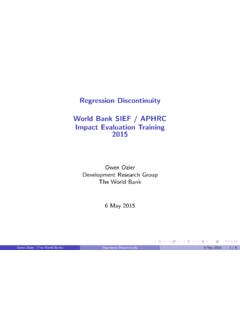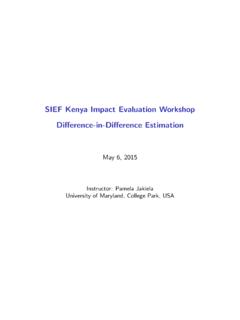Transcription of Malaysia Economic Monitor The Quest for …
1 1 Malaysia Economic MonitorThe Quest for productivity Growth2 Contents RECENT Economic DEVELOPMENTS AND OUTLOOK External environment Domestic Economic developments Outlook THE Quest FOR productivity growth productivity Macroeconomic overview productivity Country Benchmarking productivity of Manufacturing Firms3 Sluggish global Economic : World Bank staff calculationsAnnual growth rate, % and DevelopingPrevious estimate (Jan. 2016) commodity prices bottoming : World Bank Commodity Price Data (Pink Sheet).Commodity Price the commodity balance stabilizes Source: CEIC, DOSM, World Bank staff calculationsBalances, % of GDP (last four quarters)-5-3-1135791113152009Q12009Q320 10Q12010Q32011Q12011Q32012Q12012Q32013Q1 2013Q32014Q12014Q32015Q12015Q32016Q12016 Q3 Commodity BalanceNon-Commodity CA Balance6 The current account balance has increasedSource.
2 World Bank staff calculationsBalances, % of GDP (last four quarters) TransfersPrimary and Secondary IncomeServices BalanceGoods BalanceCurrent Account7 Fiscal consolidation continues despite lower oil-related revenues Source: MOF, World Bank staff calculationsBalances of the Federal Government, percent of growth remains resilient supported by private consumptionSource: CEIC, DOSM, World Bank staff calculationsContribution to GDP, consumptionFixed investmentChange in inventoriesGovernmentNet exportsReal GDP9 Households credit growth remained on a downward trendSource: BNM, World Bank staff calculationsLoans outstanding (banking system).
3 Y/y change of 12-mth moving averages,% carsResidential propertyPersonal useCredit cardsTotal, Households10 Portfolio outflows were registered in Q3 Source: CEIC, DOSM, World Bank staff calculationsPortfolio flows, RM billion-30-25-20-15-10-50510152025Q1 2013Q2 2013Q3 2013Q4 2013Q1 2014Q2 2014Q3 2014Q4 2014Q1 2015Q2 2015Q3 2015Q4 2015Q1 2016Q2 2016Q3 2016 ResidentsNon-residentsNet portfolio flows11 Among broad depreciation of currenciesSource: CEIC, BNM, World Bank staff calculationsNote: December data as at 16 December 2016US$/ currency, Rebase Jan 2016= 1009092949698100102104106108 Thai BahtPhilippines PesoIndonesia RupiahSingapore DollarMalaysia Ringgit12 Weak but growing: Global Economic growth Commodity prices Global tradeBut higher uncertainty: Expect volatility13 GDP growth expected to slowly recover in 2016 Source: CEIC, DOSM, World Bank staff projectionsChange from last year, urban transportThe Quest for productivity growth 15 Global TFP growth has been slowing down post the global financial StockLaborTFPS ource.
4 World Development Indicators (WDI), World Bank staff calculationsSources of world Economic growth , annual growth rate, %16and the deceleration has been broad-based across all level of incomes -1012345671996-20002001-20052006-2010201 1-20141996-20002001-20052006-20102011-20 141996-20002001-20052006-20102011-2014 High incomeMiddle incomeLower middle incomeCapital StockLabourTFPS ource: WDI, World Bank staff calculationsSources of world Economic growth , annual growth rate, %17 Malaysian factor accumulation key for growthSource: WDI, World staff StockLabourTFPC ontribution to annual growth rate, %18 Malaysia s TFP growth below high income regional economiesSource: WDI, World Bank staff StockLabourTFPC ontribution to annual growth rate, % (1990-2014)19 Labour productivity in Malaysia is lower than many regional : WDI, World staff in Share of Working Age PopulationChange in Participation RateChange in Employment rateChange in ProductivityValue added growth per worker, annual growth rate, % (1990-2014) above other peer countriesSource.
5 WDI, World staff added growth per worker, annual growth rate, % (1990-2014)21 Prior to the 1998 AFC, sectors with higher labour productivity created more employment Source: WDI, World Bank staff activities*Wholesale& retailMiningAgriculture*Other activities -Finance, business services, real estate and government servicesValue added growth per worker by sector, % (1990-1998)22 After 1998, labour productivity reduced and destroyed employment in manufacturingSource: WDI, World Bank staff activities*Wholesale& retailMiningAgriculture*Other activities -Finance, business services, real estate and government servicesValue added growth per worker by sector, % (1999-2014)23 Higher productivity , key for raising income markedly in the long-runSource: WDI, World staff calculationsGDP per capita, Malaysia / Average high-income economies, % : TFP growth = 1 (S1): TFP growth = 2 (S2): S1 + labourforce Scenario 3 (S3).
6 S2 + human capital + investment24 Raising productivity should be complemented by improvement in other : DOSM, WDI, World Bank staff calculationsFemale labour force participation, % Investment as share of GDP, %303540455055602010201120122013201411MP2 0222426283020102011201220132014 Historical25 Sustained employment, in difficult sales environmentSource: World Bank Enterprise SurveysReal employment growth ; Real annual sales growth ; Labourproductivity growth , %, &OECDASEANC hinaEmploymentReal annual salesLabour productivity26 Large firms lead recent productivity : World Bank Enterprise SurveysAnnual labour productivity growth , %, (<20)Medium (20-99)Large (>100) among exporting firms particularly in MalaysiaSource: World Bank Enterprise SurveysAnnual labour productivity growth , %, &OECDASEANC hinaExporterNon-exporter28 Services performed better than manufacturingSource.
7 World Bank Enterprise SurveysAnnual labour productivity growth , %, (2012-2014) Services29 Manufacturing firms in Malaysia have higher variability of Source: World Bank Enterprise SurveysManufacturing firms TFP (2012-2014) &OECDASEANC hina25th percentileMedian75th much of the variability of TFP explained by large and small firmsSource: World staff Enterprise SurveysManufacturing firms TFP (2012-2014)0123456 MalaysiaHigh-income & OECDASEANC hinaMalaysiaHigh-income & OECDASEANC hinaMalaysiaHigh-income & OECDASEANC hinaSmall (<20)Medium (20-99)Large (>100)25th percentileMedian75th percentile31lower productivity mainly explained by non-exportersSource.
8 World Bank Enterprise SurveysManufacturing firms TFP (2012-2014)0123456 MalaysiaHigh-income & OECDASEANC hinaMalaysiaHigh-income & OECDASEANC hinaNon-exportersExporters25th percentileMedian75th percentile32 Services productivity in Malaysia seem less productive than comparator countries Source: World Bank Enterprise SurveysRatio of median labour productivity (Services/ Manufacturing) &OECDASEANC hinaMalaysiaHigh-income &OECDASEANC hinaMalaysiaHigh-income &OECDASEANC hinaSmallMediumLarge33 Benchmarking Some Potential Drivers of ProductivitySkillsInfrastructureInnovati onEfficiency34 SkillsInfrastructureInnovationEfficiency 35 Malaysia manufacturing firms have a higher share of secondary educated.
9 World Bank Enterprise SurveysShare of secondary educated workers, % of total workers020406080100 MalaysiaHigh-income & OECDASEANC hinaMalaysiaHigh-income & OECDASEANC hinaManufacturingServices36 Malaysian firms have lower vacancy rates but report more difficulties in finding skillsSource: World Bank Enterprise SurveysFirms that find difficult to find skills, %051015202530354045 TotalSmall(<20)Medium(20-99)Large(>100)MalaysiaASEAN020406080100 MalaysiaASEANV acancy rate, % 37 Malaysian firms less likely to provide training and train fewer workers, mainly small firms Source.
10 World Bank Enterprise Surveys020406080100 MalaysiaHigh-income & OECDASEANC hinaMalaysiaHigh-income & OECDASEANC hinaFirms offeringformal trainingWorkers offeredformal training0102030405060 Small (<20)Medium (20-99)Large (>100)Small (<20)Medium (20-99)Large (>100)Firms offering formaltrainingWorkers offeredformal trainingFirms that offer training, %Workers trained, %38 Malaysian SMEs that provide training have higher labour productivity and TFP Source: World Bank Enterprise SurveysMedian sales per worker, USD Median TFP, %010,00020,00030,00040,00050,00060,000 Small (<20)Medium(20-99)Large(>100)No (<20)Medium (20-99)Large(>100)No trainingTraining39 SkillsInfrastructureInnovationEfficiency 40 productivity is positively associated with innovationSource: World Bank Enterprise SurveysMedian sales per worker, USD05,00010,00015,00020,00025,00030,0003 5,000 Small (<20)Medium (20-99)Large (>100)No innovationAny innovation41 Malaysian firms mainly foc
